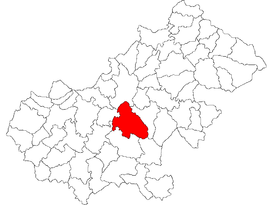| Revision as of 11:38, 8 June 2021 editMarkussep (talk | contribs)Autopatrolled, Extended confirmed users, Page movers, Pending changes reviewers, Template editors557,879 editsmNo edit summary← Previous edit | Revision as of 13:46, 5 April 2022 edit undoDicklyon (talk | contribs)Autopatrolled, Extended confirmed users, Rollbackers477,257 editsm link case fix (via WP:JWB)Next edit → | ||
| Line 19: | Line 19: | ||
| ==History== | ==History== | ||
| It has a complex history, having in different periods been part the ], ], ] and the ]. | It has a complex history, having in different periods been part the ], ], ] and the ]. | ||
| In 1920 the town became part of Romania, under the ] that concluded ]. As a result of the ] it became a part of ] between 1940 and 1945. Since then it has been part of Romania. | In 1920 the town became part of Romania, under the ] that concluded ]. As a result of the ] it became a part of ] between 1940 and 1945. Since then it has been part of Romania. | ||
Revision as of 13:46, 5 April 2022
Town in Satu Mare, Romania| Ardud | |
|---|---|
| Town | |
 Ardud fortress Ardud fortress | |
 Coat of arms Coat of arms | |
 Location in Satu Mare County Location in Satu Mare County | |
 | |
| Coordinates: 47°38′N 22°53′E / 47.633°N 22.883°E / 47.633; 22.883 | |
| Country | Romania |
| County | Satu Mare |
| Government | |
| • Mayor (2020–2024) | Ovidiu-Marius Duma (PNL) |
| Population | 6,124 |
| Time zone | EET/EEST (UTC+2/+3) |
| Vehicle reg. | SM |
| Website | orasardud |
Ardud (Template:Lang-hu, Hungarian pronunciation: ; Template:Lang-de) is a town situated in Satu Mare County, Transylvania, Romania. It administers five villages: Ardud-Vii (Erdődhegy), Baba Novac (Lajosmajor), Gerăușa (Oláhgyűrűs), Mădăras (Nagymadarász) and Sărătura (Sóspuszta).
History
It has a complex history, having in different periods been part the Kingdom of Hungary, Ottoman Empire, Habsburg monarchy and the Kingdom of Romania.
In 1920 the town became part of Romania, under the Treaty of Trianon that concluded World War I. As a result of the Second Vienna Award it became a part of Hungary between 1940 and 1945. Since then it has been part of Romania.
Demographics
| Year | Pop. | ±% |
|---|---|---|
| 1869 | 4,357 | — |
| 1880 | 4,071 | −6.6% |
| 1890 | 4,926 | +21.0% |
| 1900 | 5,742 | +16.6% |
| 1910 | 6,302 | +9.8% |
| 1930 | 7,313 | +16.0% |
| 1941 | 8,047 | +10.0% |
| 1992 | 6,572 | −18.3% |
| 2002 | 6,486 | −1.3% |
| 2011 | 5,889 | −9.2% |
| Source: Census data | ||
The 2011 census recorded a total population of 5,889. Of these, 59.2% were Romanians, 18.6% Hungarians, 16.1% Roma and 4.8% Germans. In 2002, 41.7% were Romanian Orthodox, 32.7% Roman Catholic, 13.9% Greek-Catholic, 5.1% Pentecostal, 4.2% Reformed and 2.3% Baptist.
Notable residents
- Sándor Petőfi to Júlia Szendrey married in Ardud.
- Ardud is the hometown of Hungarian archbishop, cardinal and statesman Tamás Bakócz.
International relations
See also: List of twin towns and sister cities in RomaniaArdud is twinned with:
 Trevoux (1990)
Trevoux (1990) La Martyre (1992)
La Martyre (1992) Szakoly (2004)
Szakoly (2004) Napkor (2005)
Napkor (2005) Velyki Berehy (2005)
Velyki Berehy (2005)
References
- "Results of the 2020 local elections". Central Electoral Bureau. Retrieved 8 June 2021.
- "Populaţia rezidentă după grupa de vârstă, pe județe și municipii, orașe, comune, la 1 decembrie 2021" (XLS). National Institute of Statistics.
- Census Database
- 2011 Romanian census data
- Romanian Government Department of Interethnic Relations (in Romanian) Archived July 17, 2011, at the Wayback Machine
This Satu Mare County location article is a stub. You can help Misplaced Pages by expanding it. |
